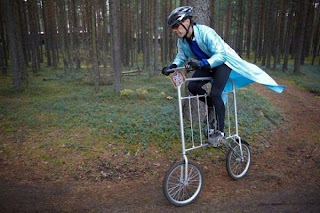After I had been cycling a few years, I began to see lycra clothing. That was around the early 1980's. It seems that everything people of my generation have grown to hate, like synth-pop and techno music, shoulder pads and big hair, started around that time.
It was truly a case of apres lycra, la deluge or something like that. The old wool and cotton jerseys had their own distinctive styles: Although they bore the names of sponsors, and were quite colorful, they could never be mistaken for anything but bike jerseys. They were not billboards or movie trailers, or imitations of other kinds of clothing (including team jerseys from other sports).
I stumbled upon a page showing just how awful bike clothing graphics have become. I think they've become so garish because lycra holds more different kinds of colors and dyes, and is easier to work on, than cotton or wool. Anyway, here is my vote for the worst jersey--actually, the worst bike outfit--of all time:
And I certainly wouldn't want to wear the uniform of this team:
If I ever get married, I forbid my husband from wearing this:
And I promise not to wear this on our honeymoon:


































